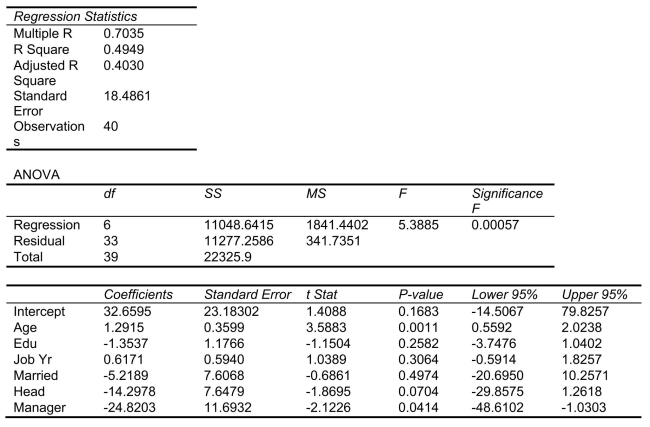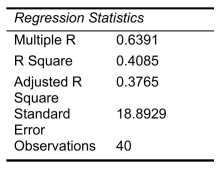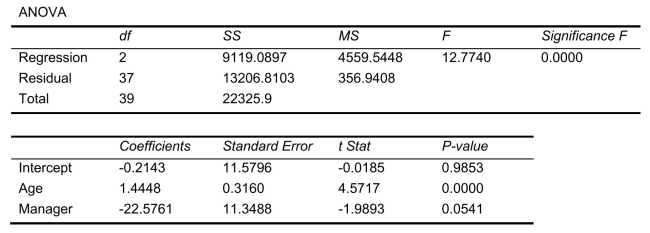SCENARIO 18-10 Given below are results from the regression analysis where the dependent variable is the number of weeks a worker is unemployed due to a layoff (Unemploy)and the independent variables are the age of the worker (Age), the number of years of education received (Edu), the number of years at the previous job (Job Yr), a dummy variable for marital status (Married: 1 = married, 0 = otherwise), a dummy variable for head of household (Head: 1 = yes, 0 = no)and a dummy variable for management position (Manager: 1 = yes, 0 = no).We shall call this Model 1.The coefficient of partial determination  of each of the 6 predictors are, respectively, 0.2807, 0.0386, 0.0317, 0.0141, 0.0958, and 0.1201.
of each of the 6 predictors are, respectively, 0.2807, 0.0386, 0.0317, 0.0141, 0.0958, and 0.1201.  Model 2 is the regression analysis where the dependent variable is Unemploy and the independent variables are Age and Manager.The results of the regression analysis are given below:
Model 2 is the regression analysis where the dependent variable is Unemploy and the independent variables are Age and Manager.The results of the regression analysis are given below: 

-Referring to Scenario 18-10 Model 1, we can conclude that, holding constant the effect of the other independent variables, the number of years of education received has no impact on the mean number of weeks a worker is unemployed due to a layoff at a 1% level of significance if all we have is the information of the 95% confidence interval estimate for  .
.
Definitions:
Bulimia
An eating disorder marked by binge eating followed by methods to avoid weight gain, such as self-induced vomiting, fasting, or excessive exercise.
Young People's Health
Refers to the physical, mental, and social well-being of individuals in their late childhood, adolescence, and early adulthood.
Marijuana
A psychoactive drug derived from the Cannabis plant, used for recreational or medicinal purposes.
Adolescents
Individuals in the developmental stage bridging childhood and adulthood, typically ranging from the early teenage years to the early twenties.
Q50: Successful implementation of a classification tree requires
Q66: Referring to Scenario 17-1, the sparklines enable
Q84: Referring to Scenario 18-10 Model 1, _
Q89: Referring to Scenario 18-1, one individual in
Q95: The prescriptive analytics technique in which the
Q95: Referring to Scenario 16-6, the estimate of
Q122: Common causes of variation are correctable without
Q123: Referring to Scenario 20-6, the optimal strategy
Q131: Referring to Scenario 19-4, suppose the supervisor
Q163: Referring to Scenario 16-12, to obtain a